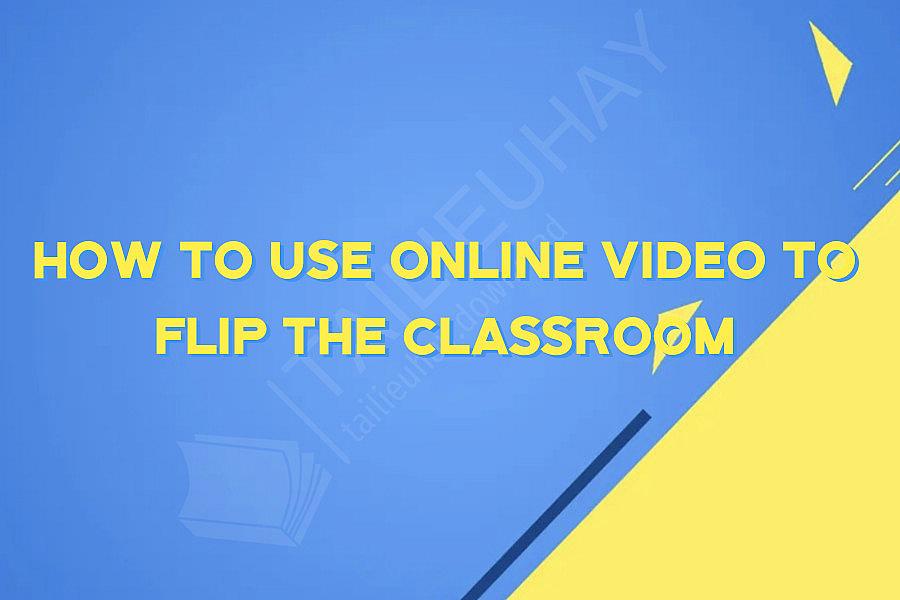How to Use Online Video to Flip the Classroom

Flipping the classroom has become a buzzword in education over the past few years. It refers to a teaching method where students watch instructional videos online at home, freeing up class time for interactive and collaborative activities. This approach allows teachers to personalize learning, promote mastery and collaboration, and enhance student engagement and motivation. To implement this teaching method effectively, teachers need to know how to use online video platforms. Here are some tips on how to use online video to flip the classroom.
Selecting and Creating Videos:
The first step is to identify the learning objectives and topics that need to be covered in class. Then, teachers can search for pre-existing and relevant instructional videos on platforms, such as Khan Academy, Ted Ed, and Coursera, or create their videos using tools like Screencastify, Loom, or Edpuzzle. Teachers should ensure that the videos are easy to understand, engaging, and align with the curriculum. Moreover, videos should be between five to ten minutes long and include interactive elements to ensure student engagement.
Sharing and Collaborating:
Once videos are selected or created, teachers can share them with their students using a variety of online platforms, such as Google Classroom, LMS, or social media. Teachers should also provide clear instructions on how to access and watch the videos, and set expectations on the completion of the videos before the upcoming class session. Additionally, teachers should incorporate collaborative activities in class that encourage students to share, discuss, and apply the knowledge gained from watching the videos at home.
Assessing and Feedback:
To ensure that students are engaged and mastered the materials, teachers need to assess their learning outcomes regularly. Formative assessments, such as quizzes, polls, or reflections, can be built into video lectures using tools like Edpuzzle, Flipgrid, or Nearpod. Furthermore, teachers should provide students with timely and constructive feedback on their work, and adjust their instruction accordingly based on the data.
In conclusion, using online video to flip the classroom is an effective way to personalize learning, enhance collaboration and motivation, and promote mastery. To implement this teaching method successfully, teachers need to be familiar with the various online video platforms and tools, properly select and create videos, share them with their students, and provide regular assessments and feedback. With these tips in mind, teachers can create dynamic and engaging learning environments that promote student success.
Selecting and Creating Videos:
The first step is to identify the learning objectives and topics that need to be covered in class. Then, teachers can search for pre-existing and relevant instructional videos on platforms, such as Khan Academy, Ted Ed, and Coursera, or create their videos using tools like Screencastify, Loom, or Edpuzzle. Teachers should ensure that the videos are easy to understand, engaging, and align with the curriculum. Moreover, videos should be between five to ten minutes long and include interactive elements to ensure student engagement.
Sharing and Collaborating:
Once videos are selected or created, teachers can share them with their students using a variety of online platforms, such as Google Classroom, LMS, or social media. Teachers should also provide clear instructions on how to access and watch the videos, and set expectations on the completion of the videos before the upcoming class session. Additionally, teachers should incorporate collaborative activities in class that encourage students to share, discuss, and apply the knowledge gained from watching the videos at home.
Assessing and Feedback:
To ensure that students are engaged and mastered the materials, teachers need to assess their learning outcomes regularly. Formative assessments, such as quizzes, polls, or reflections, can be built into video lectures using tools like Edpuzzle, Flipgrid, or Nearpod. Furthermore, teachers should provide students with timely and constructive feedback on their work, and adjust their instruction accordingly based on the data.
In conclusion, using online video to flip the classroom is an effective way to personalize learning, enhance collaboration and motivation, and promote mastery. To implement this teaching method successfully, teachers need to be familiar with the various online video platforms and tools, properly select and create videos, share them with their students, and provide regular assessments and feedback. With these tips in mind, teachers can create dynamic and engaging learning environments that promote student success.
Khóa Học Cùng Chủ Đề
After Effects Essentials
Build a Recommendation Engine
Complete ASP.NET Core 0 MVC Single-Page App[The FUTURE]
Complete Blockchain, Cryptocurrency, Wallet Development
Complete Ruby on Rails Single-Page App [The FUTURE]
Getting Started with Maya 2017
Musketeers App online roulette numbers forecasting App
Premiere Pro 101
SQUATS FROM A TO Z
The Maxx You Project How To Capture an Authentic You
12 Small Programs in Java
3ds max making of subway train
7 Scientifically Proven Steps to Increase Your Influence
Adobe Flash CS5 for Beginners
Adsense Masterclass 2018